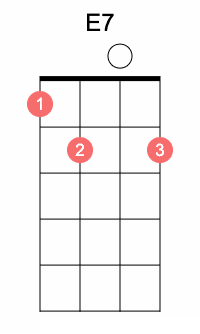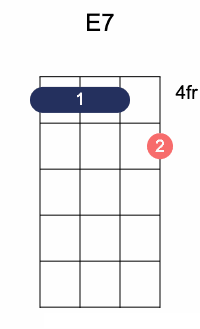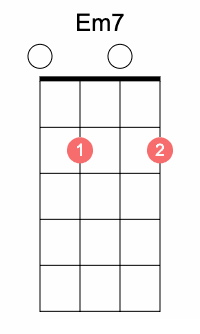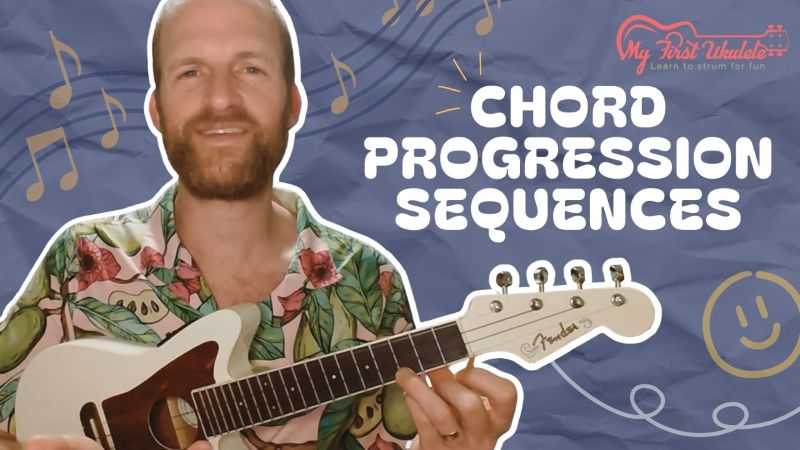Written by Jay Searle / Published January 29, 2024
Last updated: February 22, 2024
The chord that helped innumerable popular songs reach the charts, the E7 uke chord is a simple combination of notes G#, D, E, and B. It’s among the most versatile chords in the book, featuring over 40+ possible combinations and alternative versions.
The ukulele E7 chord can also be considered an embellishment of the even simpler Em7 (E Minor 7th).
Today, we’re here to help you learn how to play this uke chord, use it while covering or making your own songs, and provide you with simple tips regarding how to master the famous E7. Let’s start by breaking this chord down.
How to Play the E7 Ukulele Chord

In essence, this uke chord is comprised of G# in the first position of the G string; D in the second position of the C string; the open E string, and B in the second position of the A string.
The most common finger positioning scheme for the E7 ukulele chord is as follows:
- A: Ring finger on the second fret.
- E: Open.
- C: Middle finger on the second fret.
- G: Index finger on the first fret.
However, you can swap the order of your middle and ring finger positions in case it feels easier or more natural.
A common mistake most beginners make is forming a bar chord over the entire second fret, accidentally pressing the F# note. This is only valid if you’re about to play a Dmaj7 after, but you should practice pressing each fret individually for the sake of accuracy.
Alternate E7 Ukulele Chord Finger Positions & Similar Chords
The ukulele E7 chord isn’t overly complex, but some first-time players struggle with it. We’re here to recommend a few alternate finger positioning styles and chords with a similar sonic composition, so give them a try if the standard version is causing you problems.
B-E-G#-D Version of the E7 Ukulele Chord

The easiest way to play the E7 chord without your fingers getting in each other’s way is to move down the fretboard to the fourth fret. This time, G# and D are played an octave higher, and the hard-to-reach B can now be fretted alongside G# and E by simply forming a bar chord over the fourth fret. This allows you to easily press D with your middle finger, so just follow these instructions to learn how to play this E7 variant:
- A: Middle finger on the fifth fret.
- E: Bar chord with your index finger on the fourth fret.
- C: Bar chord with your index finger on the fourth fret.
- G: Bar chord with your index finger on the fourth fret.
E minor 7 (Em7) – Just One Note Different from E7

An alternative, albeit somewhat “sadder” chord to the E7 is the E Minor 7. How is it different? Well, the G# has been ‘flattened’ (moved one fret down) to the open G. In music theory you will hear this referred to as the minor third, that is, G is the minor third of Em7, whereas the G# was the major third of the E dominant 7 chord (E7). Don’t worry if this makes no sense to you yet, it will in time.
In the Em7 chord, only the notes D and B are fretted while the strings G and E are left open. Although you’ll have to deal with the same issue of pressing the same fret with two fingers, you’ll have an extra finger to choose from while deciding how to do it.
We recommend the following Em7 finger positioning style, although feel free to modify it to suit your preferences:
- A: Middle finger on the second fret.
- E: Open.
- C: Index finger on the second fret.
- G: Open.
Easy E7 Uke Chord Progressions
The sonic “signature” of the E7 is neither too happy nor too somber. This means that it can easily begin or end the progression, or fit somewhere in the middle. However, it doesn’t sit well with every ukulele chord imaginable, so we’d like to recommend a few easy progressions that most beginners find enjoyable to play.
E7-C-F-G: “The Usual Suspects”

As a versatile ukulele chord, E7 works like a charm alongside the three most common uke chords – C, F, and G. This particular lineup is ideal for ballads, although you can easily put it to use when making intros, outros, or bridges. Feel free to play with the order and come up with your own cool progressions!
Check out our beginner ukulele chords lesson for tips on how to play the C, F, and G chords.
Am-Dm-G-E7: “Chromatic Melancholy”

A slightly more complex progression favoring more emotional atmospheres, the combination of Am, Dm, G, and E7 is a recipe for classic love songs or spooky Halloween themes – depends on how you play it.
Learn how to play these chords:
Oddly enough, similar chords are included in the soundtrack of the famous Addams Family series, but you can also hear them in California Sun by GUGUG. Go ahead and have a jam, mixing and matching the chords as you best see fit.
Final Words
The E7 ukulele chord can be very enjoyable to play once you’ve mastered its intricate finger positioning styles. Feel free to experiment and explore beyond the progressions we’ve recommended – it can fit virtually anywhere. We hope that this guide has helped you on your way to mastering the E7 ukulele chord.

Jay Searle
Website Founder & WriterJay is a self-professed music nerd and ukulele lover. When not working on the website you’ll find him strumming along to his favorite tunes, spending time with his family, or learning to play the piano.





